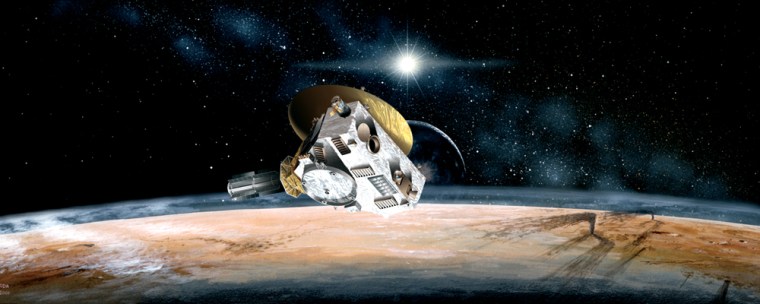It will be the fastest spacecraft ever launched, zooming past the moon in nine hours and reaching Jupiter in just over a year at a speed nearly 100 times that of a jetliner.
Its target is Pluto — the solar system's last unexplored planet, 3 billion miles (4.8 billion kilometers) from Earth. And the New Horizons spacecraft, set for liftoff on Tuesday, could reach it within nine years.
Pluto, a tiny, icy misfit of a planet — some say it's not a planet at all — neither resembles the rocky bodies of Mercury, Venus, Earth and Mars, nor the giant gaseous planets of Jupiter, Saturn, Uranus and Neptune. For years after its discovery 75 years ago, it was considered a planetary oddball.
But in recent years, astronomers have come to realize that Pluto's class of planetary bodies, ice dwarfs, isn't so odd after all. In fact, ice dwarfs are the most populous group in the solar system. Now, scientists have a chance to learn more about them and the origins of the planetary system.
"Just as a Chihuahua is still a dog, these ice dwarfs are still planetary bodies," said Alan Stern of the Southwest Research Institute in Boulder, Colo., the mission's principal investigator. "The misfit becomes the average. The Plutolike objects are more typical in our solar system than the nearby planets we first knew."
Voyage to the Kuiper Belt
When the 7-foot-tall (2.1-meter-tall) New Horizons spacecraft reaches Pluto as early as 2015, the spacecraft will study the ninth planet's large moon, Charon, as well as two other moons just discovered last year. The $700 million mission should provide scientists with a better understanding of the Kuiper Belt, a mysterious region that lies beyond Neptune at the outer limits of the planetary system.
Besides being home to Pluto, the Kuiper Belt is believed to hold thousands of comets and icy planetary objects that make up a third zone of the solar system, the rocky and gaseous planets making up the other two. Scientists believe they can learn about the evolution of the solar system by studying the Kuiper Belt since it possesses debris left over from the formation of the outer solar system. Depending on its fitness after arriving at Pluto, New Horizons will attempt to identify one or two objects in the Kuiper Belt.
"It provides for us a window 4 1/2 billion years back in time to observe the formation conditions of giant planets," Stern said. "This is a little bit about rewriting the textbooks about the outer planets."
The last planet
A successful journey to Pluto will complete a survey of the planets that NASA began in the early 1960s with the Mariner program's exploration of Mars, Mercury and Venus by unmanned spacecraft. The best images of Pluto currently come from the Hubble Space Telescope, but they suffer from low-resolution fuzziness, making it difficult for scientists to interpret what they're seeing.
The 1,054-pound (480-kilogram) piano-sized spacecraft will be launched on an Atlas 5. The rocket's makers, Lockheed Martin, experienced problems on another Atlas propellant tank similar to the one being flown to Pluto, forcing a delay of New Horizons' launch by several days to give the contractor extra time for inspection.
"Because we have such a long way to go, we put this small spacecraft on one of the largest rockets the U.S. has in its inventory," said project manager Glen Fountain of the Johns Hopkins University Applied Physics Laboratory.
When New Horizons reaches Jupiter in 13 months, it will use that giant planet's gravity as a slingshot, shaving five years off the trip to Pluto. During the trip between Jupiter and Pluto, the probe will go into hibernation, closing down most systems to conserve power. It will send weekly "beeps" back to Earth, providing updates on the vehicle's condition.
If the spacecraft is unable to launch during its monthlong window that closes Feb. 14, the next opportunity is in February 2007, but that would push back an arrival at Pluto to 2020 since New Horizons wouldn't be able to get the gravity assist from Jupiter then.
Radioactive power
Powered by radioactive fuel that will produce less energy than is used by two 100-watt lightbulbs, New Horizons is loaded with seven instruments that will be able to photograph the surfaces of Pluto and Charon and examine Pluto's atmospheric composition and structure. Two of the cameras, Alice and Ralph, are named for the bickering couple from television's "The Honeymooners."
The spacecraft has a thermos-bottle design that will allow it to stay at room temperature. Tucked inside the probe will be a U.S. flag and a CD containing about a half million names of ordinary citizens who signed up on a NASA Web site.
Pluto and the Kuiper Belt have been full of surprises in recent years.
Scientists discovered in 2001 that binary objects — pairs like Pluto and Charon — litter the Kuiper Belt, and a year later they learned that Pluto's atmosphere undergoes rapid and dramatic global change. Last summer, scientists discovered Pluto's two extra moons.
Scientists expect more unexpected discoveries from the New Horizons mission.
Said Stern, "You can see why we think it's going to be like kids in a candy shop."
